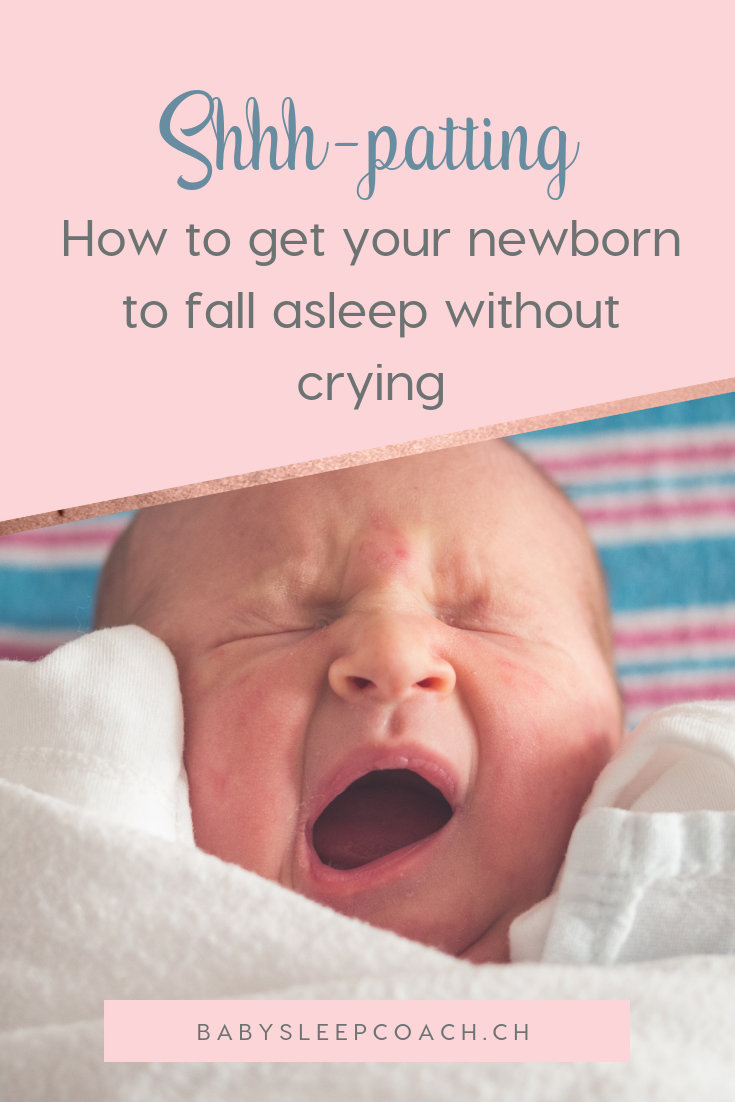The “Shhh-pat” method from Tracy Hogg, the Baby Whisperer, is one of my absolute favourites for settling babies newborn till about 5-6 months. Often babies in this age group aren’t quite able to calm themselves when they are a little worked up, and this method is super practical and easy to follow for parents wanting to help their little ones get the rest they need, without having to resort to rocking/feeding/driving baby to sleep for each nap. It is the perfect method in that babies are given the parental assistance and closeness they need, while still being given the chance to ease into more independent settling when they are ready.
How to implement the “Shhh-Pat Method”
1. At nap-time or bedtime, swaddle your little one and do your normal sleep ritual, being careful to keep the age appropriate awake time in mind so that your baby is not going to sleep under- or over-tired. (You can find the age-appropriate approximate awake times in this blog post, or check out our sleep and feed schedule guidebook for various ages.)
Your sleep ritual might look something like this: go into dimmed room, change diaper, swaddle baby, hold baby either while sitting or walking to help baby become drowsy, then turn out all lights and place baby gently in his cot on his back.
2. Keep your hands on baby’s chest and wait a few seconds to see how baby reacts. If he begins to cry, gently turn baby onto his side while supporting the chest with one hand and using the other hand to pat the back in a slow rhythmic motion in the centre of the back.
3. At the same time, make a “shhh” noise. This may need to be quite loud at the beginning, depending on baby’s cry, and get softer as baby calms and begins to settle. (There are also apps or devices, such as the Baby Shusher, that make the “shhhh” noise for you, as sometimes doing this for a few minutes can make the mouth quite dry!! 😜)
4. Continue shhhh-patting for 7-10 minutes and baby should calm down. Babies will often cry, even when held, before a nap as they release stress and emotions. This is fully ok, however, if you feel that baby is just not at all settling, put baby up to your shoulder, as you continue shhh-patting, and then when baby has calmed down, put him back gently into the cot and continue.
5. As baby starts to drift off to sleep, don’t stop the shhh-patting too quickly, as this can startle baby awake, and you have to begin the process from the beginning again. It often takes a baby about 20 minutes to be fully in a deep sleep, so try to shhh-pat till you are really sure baby is deeply asleep, and then gradually begin to shhh more quietly and pat more softly, until you’ve stopped completely.
6. Once you’ve stopped shhh-patting completely, stand and wait near your baby’s bed quietly for another couple of minutes until you’re sure that baby is asleep, and then leave the room quietly.
When can you use “Shhh-patting”
- At the beginning of a nap or bedtime to settle baby
- In the middle of a nap when baby wakes too early
- To wean off a feeding/sucking/rocking to sleep association
- To resettle baby in the middle of the night when baby wakes and it is not time for a feed yet
Important notes:
Make sure that you don’t shhhh INTO babies ear, rather past it, otherwise this may cause ear drum damage.
Pat in the centre of babies back, not on the lower back close to the kidneys.
This method works well on babies newborn till abut 5-6 months old, as long as baby is still swaddled. It does not work on un-swaddled or older babies, as it is too overstimulating, and may actually take longer for baby to settle.
If you’ve been wondering how to get your newborn to fall asleep without all the crying, give this method a try. I hope you found this post helpful. For more sleep tips, browse through my blog archives.
Don’t forget to subscribe to our newsletter down below, and you’ll immediately receive the “3 Simple Steps to a Good Night’s Sleep” e-guide that’s packed with useful information and tips that will help make sleep easier for your little one.
Struggling to see the end to sleepless nights and exhausting bedtimes with your newborn? Check out our newborn sleep guide with lots of practical tips for supporting better sleep in newborns, reducing night sleep issues and supporting nights without any sleep training.

